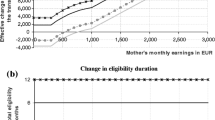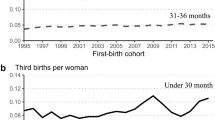Abstract
Economic theory suggests that incentives matter for people’s decisions. This paper investigates whether this also holds for less self-evident areas of life such as the timing of births. We use a natural experiment when the German government changed its parental benefit system on January 1, 2007. The policy change strongly increased economic incentives for women to postpone delivery provided that they were employed. Applying a difference-in-difference-in-difference approach, we find very strong evidence that women with an employment history near to the end of their term indeed succeeded to shift births to the New Year and, therefore, could benefit from the new and more generous parental benefit system. Suggesting a model of chain reactions, we also report evidence that some women with due dates earlier in December tried but did not succeed to shift births to the New Year.



Similar content being viewed by others
Notes
Note that from the perspective of using control years which show the same day pattern in a time window 7 days before and 7 days after the policy change, the 2000–2001 pair of years would have been particularly interesting as in this respect it is equivalent to the treatment years 2006 and 2007. However, it happens that in these years, a legislative change in educational benefits occurred.
All quotes were translated by the authors.
While we study incentives to shift birth for women already being pregnant having an employment history or not, there is also a literature studying fertility in relation to women’s employment. See, e.g., Gutierrez-Domenech (2008).
The corresponding bills from which this information is taken are the Bundeserziehungsgeldgesetz (BErzGG) and the Bundeselterngeld- und Elternzeitgesetz (BEEG).
See Appendix for more details on income limits.
Kluve and Tamm (2012) evaluate the taking up of leaves of the German parental benefit reform.
This assumes a net yearly income of 32,239 in which case no transfers would have been paid for the first 6 months under the old regime and from month 7–12 transfers would have been cut by 7.2% in relation to the income exceeding a threshold of 30,000 euros.
Two examples taken from the household income records of the Statistische Bundesamt may help bring the transfers from the parental benefit into perspective with gross incomes and net incomes after tax and social security payments. According to Statistisches Bundesamt (2008), a single parent’s gross monthly labor income was EUR 1,255 on average in year 2006. He or she had to pay EUR 151 taxes and EUR 251 in social security contributions. Thus, the base for calculating the parental benefit would have been EUR 853. As a second example, take the average gross monthly household labor income of a couple with children. This amounted to EUR 3,719 with tax and social security contributions being EUR 537 and EUR 606, respectively. If both partners contributed equally to the household income, then the base for calculating the 67% of transfers is EUR 1,288.
The employment rate of women for the data on which Table 2 is based is 39.8% compared to 45.5% in our sample. Sample sizes are available from the authors upon request.
See the Bundestagsdrucksache 16/1889 dated June 20, 2006.
C.f. Bundestagsdrucksache 16/2454 dated August 25, 2006.
See the Bundesgesetzblatt Jahrgang 2006 Teil 1 Nr. 56, issued in Bonn on December 11, 2006.
See Süddeutsche Zeitung, Regionalausgabe, December 30, 2006.
No standard errors are reported as they directly follow from the means given that we have dummy variables.
A referee suggested that the differences between employed and not employed women might be driven by differing access to health care. But this occurs unlikely to us given the egalitarian German health-care system under which 85% are covered by the public health insurance (Hajen et al. 2010) which provides equal service by law.
Additional descriptive statistics is provided in the Appendix.
Readers might be concerned about an analysis of delays of birth by 3 weeks given that births may not be shifted by more than a few days. While we, in principle, agree on the impossibility to postpone birth by more than a few days, one has to take into account uncertainty related to conception and gestation periods. These uncertainties combine to uncertainty regarding the natural delivery date and warrant, from our point of view, such an analysis.
References
Ai C, Norton EC (2003) Interaction terms in logit and probit models. Econ Lett 80:123–129
Bundesagentur für Arbeit (2010) Amtliche Nachrichten der Bundesagentur für Arbeit, Arbeitsmarkt 2010, Arbeitsmarktanalyse für Deutschland, West- und Ostdeutschland. Bericht 58 (2), Nürnberg
Bundesministerium für Familie, Senioren, Frauen und Jugend (2008) Evaluation des Gesetzes zum Elterngeld und zur Elternzeit, 2008. Endbericht, Rheinisch-Westfälisches Institut für Wirtschaftsforschung: J. Kluve, C. M. Schmidt, M. Tamm, B. Winter
Chandra A, Baker L, Dickert-Conlin S, Goodman D (2004) Holidays and the timing of births in the United States. MIT, mimeo
Coomarasamy A, Knox EM, Gee H, Song F, Khan K (2003) Effectiveness of nifedipine versus atosiban for tocolysis in preterm labour: a meta-analysis with an indirect comparison of randomised trials. BJOG-Int J Obstet Gy 110:1045–1049
Dickert-Conlin S, Chandra A (1999) Taxes and the timing of births. J Polit Econ 107(1):161–177
Eliason M, Ohlsson H (2008) Living to save taxes. Econ Lett 100:340–343
Eliason M, Ohlsson H (2010) Timing of death and the repeal of the Swedish inheritance tax. Working Paper No. 2010:2, Uppsala Center for Fiscal Studies, Department of Economics, Uppsala University
Gans JS, Leigh A (2006) Did the death of Australian inheritance taxes affect deaths? Top Econ Anal Pol 6(1):1–7
Gans JS, Leigh A (2009) Born on the first of July: an (un)natural experiment in birth timing. J Public Econ 93(1–2):246–263
Gutierrez-Domenech M (2008) The impact of the labour market on the timing of marriage and births in Spain. J Popul Econ 21(1):83–110
Hajen L, Paetow H, Schumacher H (2010) Gesundheitsökonomie: Strukturen, Methoden, Praxis, 5th edn. Kohlhammer, Stuttgart
Khashan A, McNamee R, Abel K, Mortensen P, Kenny L, Pedersen M, Webb R, Baker P (2009) Rates of preterm birth following antenatal maternal exposure to severe life events: a population-based cohort study. Hum Reprod 24(2):429–437
Kluve J, Tamm M (2012) Parental leave regulations, mothers’ labor force attachment and fathers’ childcare involvement: evidence from a natural experiment. J Popul Econ. doi:10.1007/s00148-012-0404-1
Kopczuk W, Slemrod J (2003) Dying to save taxes: evidence from estate-tax returns on the death elasticity. Rev Econ Stat 85(2):256–265
Maghakian T, Schulkind L (2010) What a difference a day makes: a new look at child tax benefits and the timing of birhts. University of California, Davis, mimeo
Norton EC, Wang H, Ai C (2004) Computing interaction effects and standard errors in logit and probit models. Stata J 4(2):154–167
Statistisches Bundesamt (2008) Statistisches Jahrbuch 2008. Statistisches Bundesamt
Tamm M (2009) The impact of a large parental leave benefit reform on the timing of birth around the day of implementation. Ruhr Economic Papers 98, Rheinisch-Westfälisches Institut für Wirtschaftsforschung
Acknowledgements
This work started when Neugart was affiliated with the Wissenschaftszentrum Berlin für Sozialforschung which generously supported data purchase. Some of the work was done when Ohlsson enjoyed the hospitality of LEM, Université Panthéon-Assas, Paris II. This project was financially supported by a grant of the Central Research Committee of the Free University of Bozen/Bolzano. We would also like to thank the Forschungsdatenzentrum der Länder im Amt für Statistik Berlin-Brandenburg, in particular Matthias Klumpe, for their support in handling the data. Helpful comments and suggestions from Mikael Elinder, Jochen Kluve, Håkan Selin, and seminar participants at Bielefeld, London, and Växjö are gratefully acknowledged.
Author information
Authors and Affiliations
Corresponding author
Additional information
Responsible editor: Junsen Zhang
Appendix
Appendix
-
Before (Erziehungsgeld):
-
In 300 euro option, no transfers were paid within the first 6 months if the yearly income of couples was above 30,000 euros and of singles above 23,000 euros; from the seventh month onwards, transfers were paid at a reduced amount if the income was above 16,500 for couples or 13,500 singles. The reduced amount was calculated as 300 euros minus 5.2% of the income exceeding the income limits.
-
In 450 euro option, no transfers were paid within the first 6 months if the yearly income of couples was above 30,000 euros and of singles above 23,000 euros; from the seventh month onwards, transfers were paid at a reduced amount if the income was above 16,500 for couples or 13,500 singles. The reduced amount was calculated as 300 euros minus 7.2% of the income exceeding the income limits.
-
In both options, income limits increased by 3,140 euros for every additional child living in the household.
-
-
After (Elterngeld):
Transfer is 67% of the average net income of the 12 months preceding the birth of the baby up to a maximum of 1,800 euros. A minimum payment of 300 euros irrespective of the employment history is guaranteed.
The dataset comprises 16 states and 451 communities (Table 8).
Rights and permissions
About this article
Cite this article
Neugart, M., Ohlsson, H. Economic incentives and the timing of births: evidence from the German parental benefit reform of 2007. J Popul Econ 26, 87–108 (2013). https://doi.org/10.1007/s00148-012-0420-1
Received:
Accepted:
Published:
Issue Date:
DOI: https://doi.org/10.1007/s00148-012-0420-1




